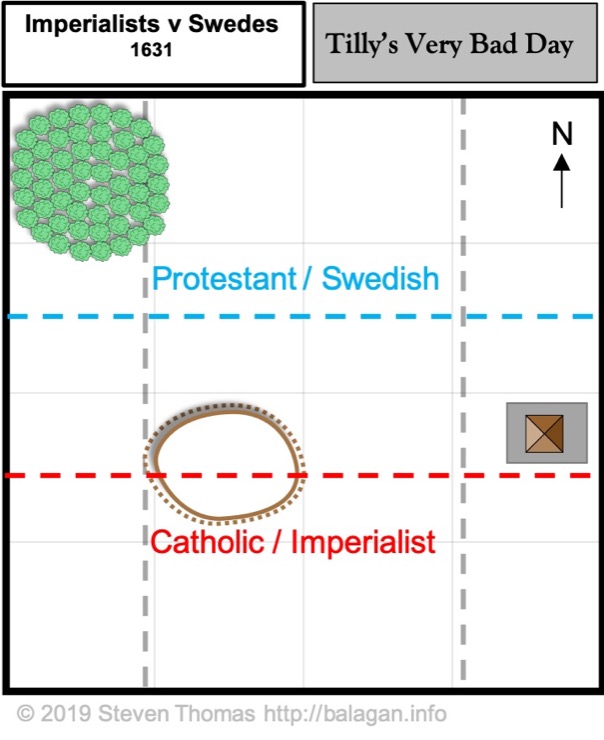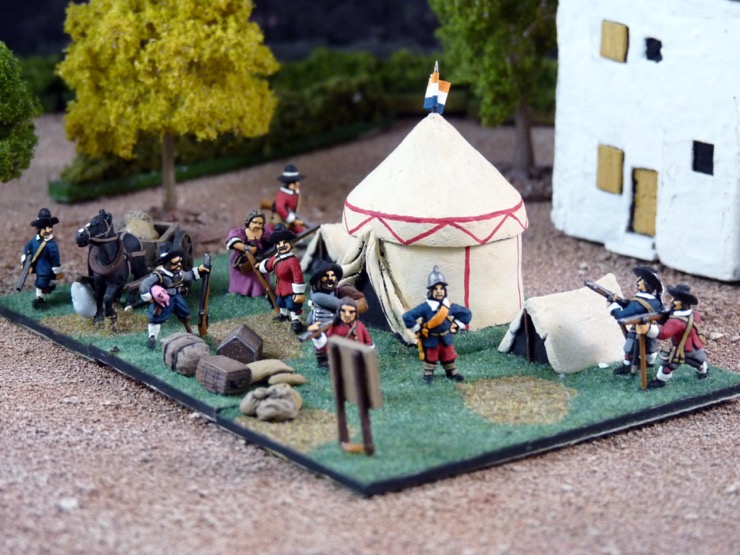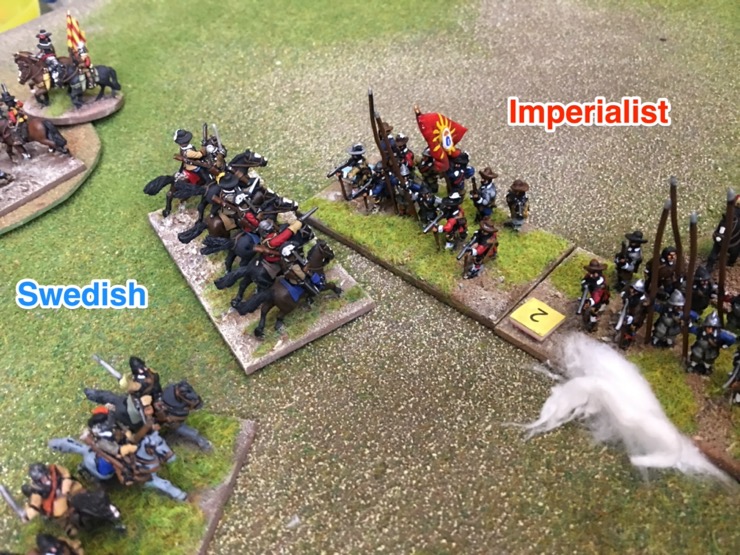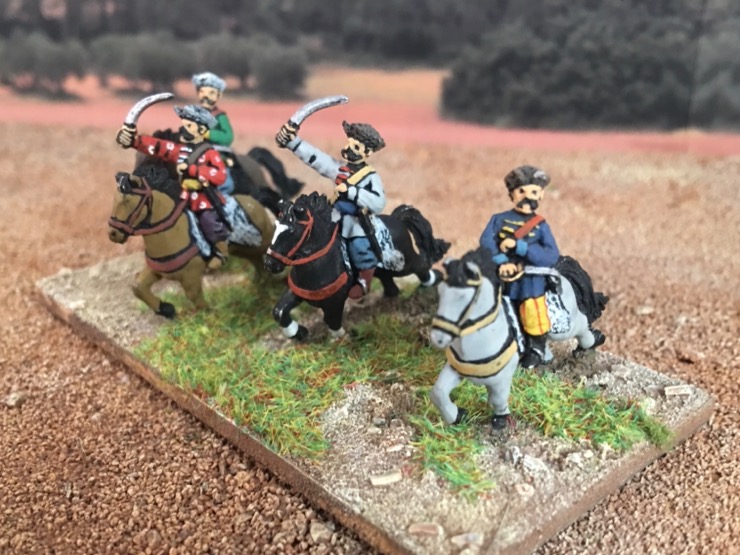This scenario represents the Battle of Fleurus (29 Aug 1622) using Tilly’s Very Bad Day. Historically the Spanish defeated the Protestant Paladins Mansfeld and Brunswick, and destroyed the Protestant infantry, but did not prevent the Protestant horse from reaching the Dutch. Given the number of troops involved in the real battle, this is a small game on a small table with small armies (in numbers of units).
Thirty Years War
In 1617 the fiercely Catholic, Ferdinand of Styria, was elected by the Bohemian Estates to become the Crown Prince of Bohemia and the heir to the throne. In May 1618 a group of Bohemian Protestants in Prague seized Ferdinand’s representatives and threw them out of the palace window. This event started the Bohemian Revolt and the Thirty Years’ War. The conflict soon spread across the Holy Roman Empire, and then the whole of Europe, involving Spain, France, Denmark, Sweden, and a number of other countries. The war ended in 1648 with the treaties of Osnabrück and Münster, part of the wider Peace of Westphalia.
Small Lutzen – A Tillys Very Bad Day Battle Report 1
Jamie and Chris play tested the pre-publication version my Small Lutzen – A Tilly’s Very Bad Day Scenario. This is a small game on a small table with small armies (in numbers of units), and only normal Pike+Shot not Large Pike+Shot.
Summary: Scenario needed tweaking before publication. Swedes couldn’t win.
Small Lutzen – A Tilly’s Very Bad Day Scenario
Tilly’s Very Bad Day has two game scales: Small Games and Big Games. I’ve already done the Big Lutzen Scenario and this is the Small Game scenario for the same battle: the Battle of Lutzen (16 November 1632) in the Thirty Years War. That means this scenario is for a small game on a small table with small armies (in numbers of units), and only normal Pike+Shot not Large Pike+Shot.
Musing on Cavalry Pursuit in Tilly’s Very Bad Day
I asked whether I should introduce baggage camps to Tilly’s Very Bad Day. Opinions where mixed, of course, but for me the big take away was baggage camps were a red herring. The thing to simulate is cavalry pursuit. The questions is how? I’ve been mulling over pursuit in a couple of contexts. I thought I’d share and see what you think. These are not well formed thoughts. Just a bit a jumble to reflect the various considerations and possibilities.
Big Lutzen – A Tilly’s Very Bad Day Battle Report 2
Adam and Jamie played my big Lutzen scenario for Tilly’s Very Bad Day.
Summary: Good game. A better game than last time. Jamie (Imperialists) beat Adam (Swedes) on Game Turn 6.
John Mumby replays Imperialist versus Swedes in Tilly’s Very Bad Day
John Mumby is one of my proof readers, and has also kindly sent through a short battle report. He replayed my Imperialists beat Swedes game of Tilly’s Very Bad Day
Factions in a multi-player Thirty Years War Campaign
I keep thinking about a multi-player Campaign for the Thirty Years War. Two of the big questions is how many factions and what are they? I take a quick look at board games for inspiration before taking a view. There are quite a few board games for the Thirty Years War. Many focus on simulating the entire war so I thought I have a look at what factions they have.
Big Lutzen – A Tilly’s Very Bad Day Battle Report 1
Chris and Adam played a very raw version of my big Lutzen scenario for Tilly’s Very Bad Day.
Summary: Good game. Some debate about how to simulate the road and ditches. Adam (Imperialists) beat Chris (Swedes) on Game Turn 6. The scenario evolved after the game.
Should I introduce baggage camps to Tilly’s Very Bad Day?
Richard (doctorphalanx) has been encouraging me to introduce baggage camps into Tilly’s Very Bad Day. I like painting up camps for DBA and I already have a camp for my Dutch army of the Thirty years War. My question is, was looting the baggage train/camp a significant event in any battles of the Thirty years War or English Civil War?
Big Lutzen – A Tilly’s Very Bad Day Scenario
This is a big Tilly’s Very Bad Day scenario for the Battle of Lutzen (16 November 1632). An outnumbered Imperialist army must hold a strong defensive position until reinforcements arrive. Historically this battle is where King Gustavus died, so was a key moment in the Thirty Years War. In game terms this is a big game on a big table with big armies.
Imperialists beat Swedes – 2 Player Game of Tilly’s Very Bad Day
Adam and Chris played an Imperialist versus Swedish match up of Tilly’s Very Bad Day. Adam and Chris have a very different play style to Jamie and I so this game played out in an interesting way. Very gritty with one giant scrimmage forming. Eventually Adam’s Imperialists took the day. We were playing several draft rules for a major revision.
Making dragoons more effective in Tilly’s Very Bad Day
In my lost post on making under represented unit types more effective in Tilly’s Very Bad Day, I have a look at dragoons in the Thirty Years War. Under the rules their main competition is shot and light horse, both under represented troop types. Based on my previous thinking on those troop types I propose some ways to modify the rules to make dragoons more valuable/useful/effective.
Making light horse more effective in Tilly’s Very Bad Day
In my week of musing on unit types in Tilly’s Very Bad Day, I thought I’d outline what light horse represent and contrast them to (heavy) horse in the Thirty Years War. I also consider some ways to modify the rules to make light horse more valuable/useful/effective.
Making (commanded) shot more effective in Tilly’s Very Bad Day
We’ve been playing Tilly’s Very Bad Day for a while and it clear some unit types don’t make the grade compared to Pike+Shot and horse. Shot, dragoons, light horse and even cannons are all unpopular. So I’m going to run a short series of posts this week with the theme of making these unit types more effective. Not surprisingly I’m starting to form ideas for a major new version of the rules.
I start with Shot because I was just musing on types of (commanded) shot in Tilly’s Very Bad Day.
Musing on types of (commanded) shot in Tilly’s Very Bad Day
Tilly’s Very Bad Day has a “Shot” troop type. I thought I’d explain my thinking behind this troop type including how it simulates “commanded shot”.















